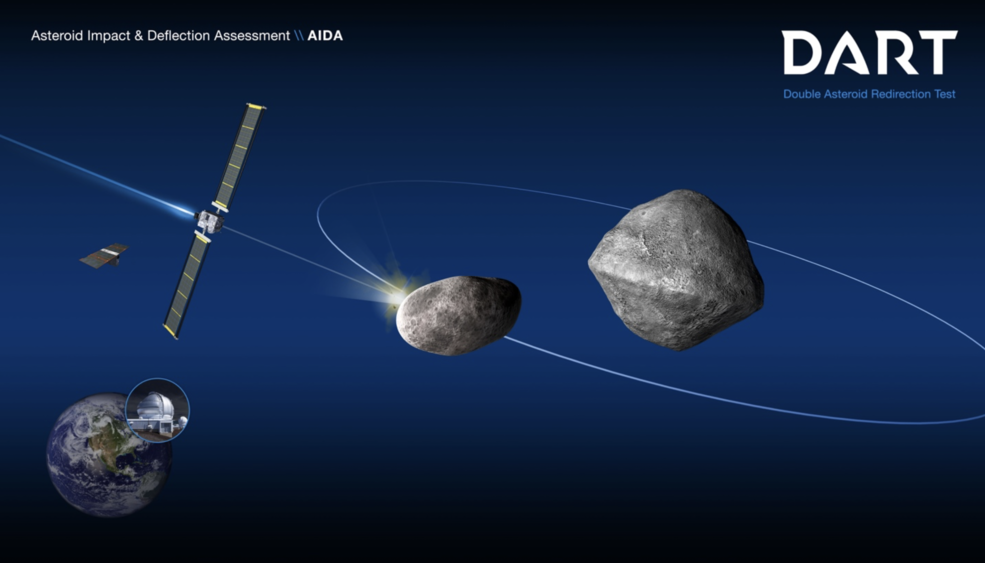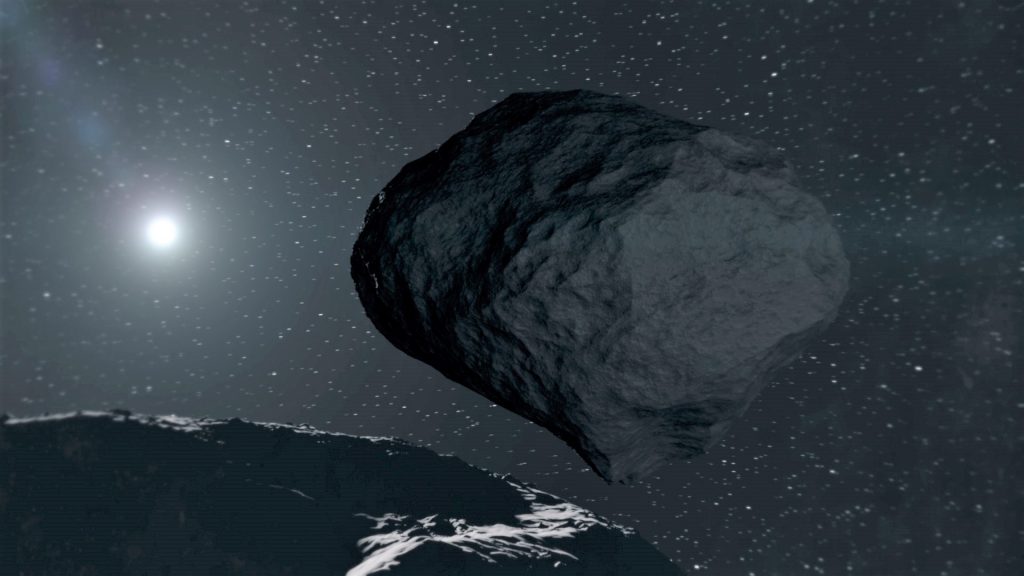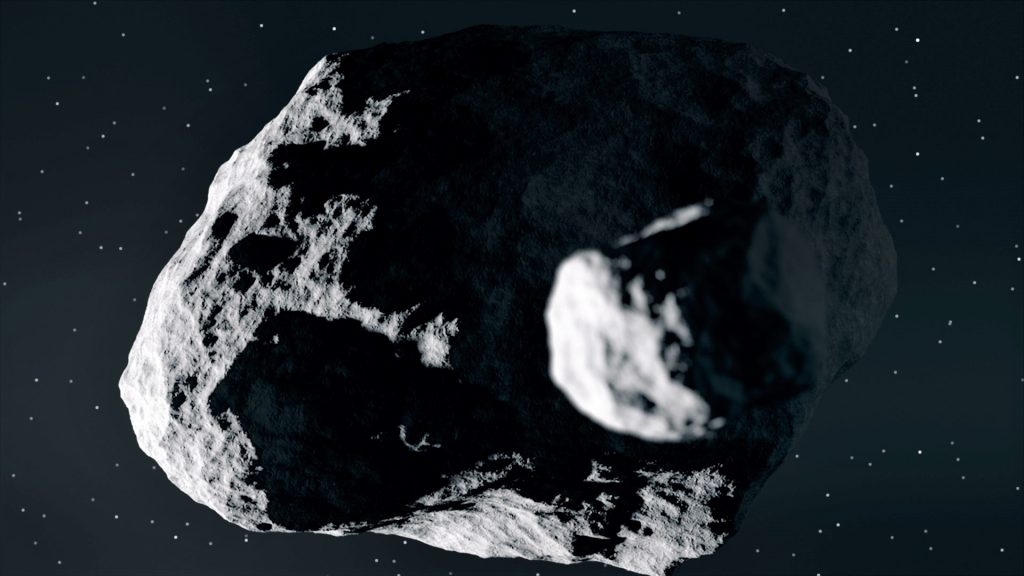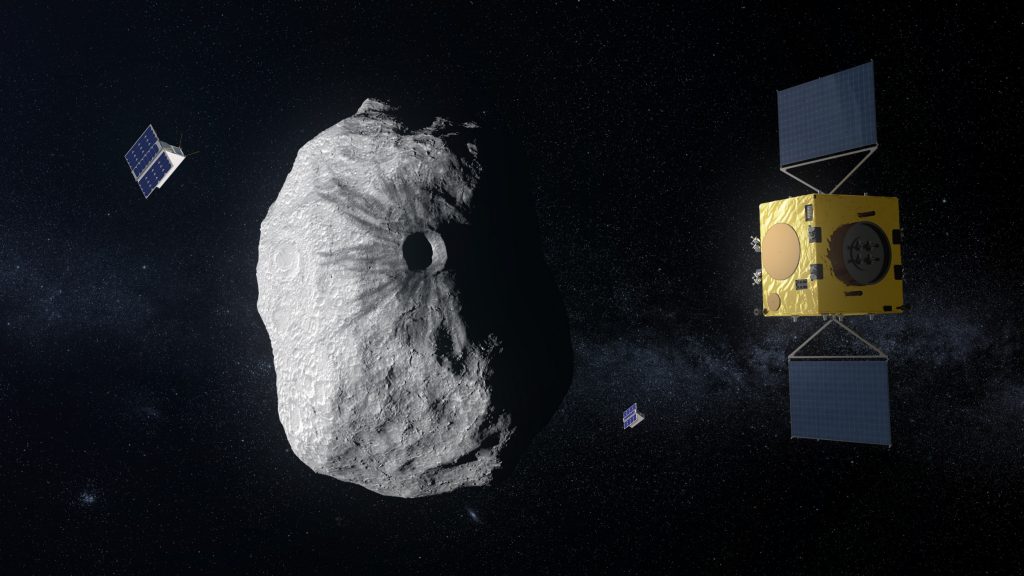AIDA collaboration highlights case for planetary defence
Surprising results from recent asteroid missions have highlighted the importance of testing planetary defence strategies in space, according to scientists participating in the joint ESA/NASA Asteroid Impact and Deflection Assessment (AIDA) collaboration. The unexpectedly large crater on asteroid Ryugu created by the JAXA Hayabysa2 impactor, together with the sand-like behaviour of material on its surface, further motivate the need to determine the effectiveness of proposed deflection techniques for an asteroid on a potential collision course with Earth. Implications are being discussed this week at the EPS-DPS Joint Meeting 2019 in Geneva.
The AIDA collaboration encompasses two missions that will demonstrate and evaluate the ‘kinetic impactor’ technique at the near-earth binary asteroid, Didymos. NASA’s Double Asteroid Redirection Test (DART) will impact the smaller of the two companions, Didymos B, in September 2022. ESA’s Hera mission, if funded at the Ministerial Conference in November this year, will rendezvous with the Didymos asteroid pair and investigate the outcome of the impact in 2027.
Didymos B – sometimes known as “Didymoon” – is around 160 metres in diameter and will be the smallest target object for a mission to date. Asteroids around 100-200 metres in size are the most common type of Near Earth Objects (NEOs) that could potentially end up on a collision course with Earth and cause regionally catastrophic devastation. However, it is thought that only about a third of these objects have been detected and tracked to date.
Dr Patrick Michel, who is presenting in sessions on planetary defence at EPSC-DPS 2019, said, “The impact with Hayabusa2 showed that there was no cohesion on the surface and the regolith behaved like pure sand. Gravity was dominating the process, rather than the intrinsic strength of the material from which the asteroid is made. If gravity is also dominant at Didymos B, even though it is much smaller, we could end up with a much bigger crater than our models and lab-based experiments to date have shown. Ultimately, very little is known about the behaviour of these small bodies during impacts and this could have big consequences for planetary defence.”
The DART mission is on track to launch in July 2021. The DART spacecraft will impact Didymos B, with the aim of shortening the time it takes the moonlet to orbit its larger companion by several minutes. Telescopes on Earth will be able to observe Didymos both before and after DART’s impact, and these observations will be used to measure the amount of deflection caused by DART’s impact. The impact will be imaged by LICIACube (Light Italian Cubesat for Imaging Asteroids), a cubesat contributed by Agenzia Spaziale Italiana (ASI), which will be deployed from the DART spacecraft a few days prior to impact.
Nancy Chabot, DART Mission Coordination Lead and Planetary Scientist at Johns Hopkins University Applied Physics Laboratory, said: “DART’s target, Didymos, is an ideal candidate for humankind’s first planetary defence experiment. It is not on a path to collide with Earth, and therefore poses no current threat to the planet. However, its binary nature enables DART to trial and evaluate the effects of a kinetic impactor.”
A primary objective of ESA’s Hera mission is to measure the mass of Didymos B to estimate how efficient the kinetic impact turned out to be. It will study the impact crater in detail and characterise the physical and mineralogical properties of the asteroid pair.
An in-depth understanding of the Didymos binary pair provided by the Hera mission, together with ground-based observations, would enable planetary defence preparations to go to a new level of planning by scaling the effects of the impact to other asteroids.
Hera has passed its system requirements review, which demonstrates that the mission can proceed into development. Following a green light at the meeting in November, in addition to start building the spacecraft, the Hera team will plan the operations at the asteroid in detail.
Last week the AIDA Consortium held a workshop in Rome to show the status of DART, LICIACube and Hera. The meeting was attended by over 100 participants from 18 countries.
Michael Kuppers said, “DART and Hera will provide valuable knowledge individually. However, when combined together through the AIDA collaboration, the scientific and technical benefits are enhanced considerably. In an even wider context, comparing the physical properties of Didymos to those of Ryugu from JAXA’s Hayabusa2 mission and the Bennu asteroid studies by NASA’s OSIRIS-REx mission will significantly contribute to our understanding of how single and multiple asteroid systems form and evolve.”
AIDA is the international ESA- and NASA-supported collaboration that will combine the data obtained from NASA’s DART mission, ASI’s LICIACube, and ESA’s Hera mission to produce the most accurate knowledge possible from the first demonstration of an asteroid deflection technology..The DART mission is being developed and led for NASA by the Johns Hopkins University Applied Physics Laboratory in Laurel, Maryland, USA.
Images

https://www.europlanet-society.org/wp-content/uploads/2019/09/dart-schematic.png

https://www.europlanet-society.org/wp-content/uploads/2019/09/Didymoon_seen_from_Didymos.jpg

https://www.europlanet-society.org/wp-content/uploads/2019/09/Didymos_and_Didymoon.jpg

https://www.europlanet-society.org/wp-content/uploads/2019/09/Hera_in_orbit.jpg
Science Contacts
Patrick Michel
Observatoire de la Côte d’Azur, CNRS
michelp@oca.eu
Nancy Chabot
Johns Hopkins Applied Physics Lab
Nancy.Chabot@jhuapl.edu
Michael Küppers
European Space Astronomy Centre (ESA/ESAC)
michael.kueppers@sciops.esa.int
Media contacts
Anita Heward
EPSC Press Officer
+44 7756 034243
epsc-dps-press@europlanet-society.org
Livia Giacomini
EPSC Press Officer
epsc-dps-press@europlanet-society.org
Adriana Postiglione
EPSC Press Officer
epsc-dps-press@europlanet-society.org
Shantanu Naidu
DPS Press Officer
dpspress@aas.org
Notes for Editors
EPSC-DPS Joint Meeting 2019
The 2019 Joint Meeting (www.epsc-dps2019.eu) of the European Planetary Science Congress (EPSC) of the Europlanet Society and the Division for Planetary Sciences (DPS) of the American Astronomical Society (AAS) will take place at the Centre International de Conférences de Genève (CICG), Geneva, Switzerland, from Sunday 15 to Friday 20 September 2019. More than 1950 abstracts have been submitted and over 1500 planetary scientists from Europe, the US and around the world are expected to attend the meeting, making it one of the largest gatherings of planetary scientists held in Europe to date.
The EPSC-DPS Joint Meeting 2019 will be the third time that EPSC and the DPS Annual Meeting have been held together.
Follow: @europlanetmedia#EPSCDPS2019
Europlanet
The Europlanet Society, launched in September 2018, is an organization for individual and corporate members to promote the advancement of planetary science and related fields in Europe. The Society provides Europe’s planetary science community with a platform to exchange ideas and personnel, share research tools, data and facilities, define key science goals for the future, and engage stakeholders, policy makers and European citizens with planetary science. The Europlanet Society is the parent organisation of the European Planetary Science Congress (EPSC).
Europlanet Society website: www.europlanet-society.org
EPSC-DPSC 2019 Joint Meeting 2019 website: www.epsc-dps2019.eu
DPS
The Division for Planetary Sciences (DPS), founded in 1968, is the largest special-interest Division of the American Astronomical Society (AAS). Members of the DPS study the bodies of our own solar system, from planets and moons to comets and asteroids, and all other solar-system objects and processes. With the discovery that planets exist around other stars, the DPS has expanded its scope to include the study of extrasolar planetary systems as well.
The AAS, established in 1899, is the major organization of professional astronomers in North America. The membership (approx. 7,500) also includes physicists, mathematicians, geologists, engineers, and others whose research interests lie within the broad spectrum of subjects now comprising contemporary astronomy. The mission of the AAS is to enhance and share humanity’s scientific understanding of the universe, which it achieves through publishing, meeting organization, education and outreach, and training and professional development.

